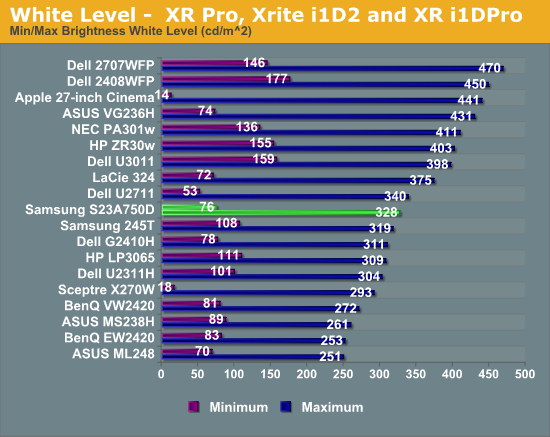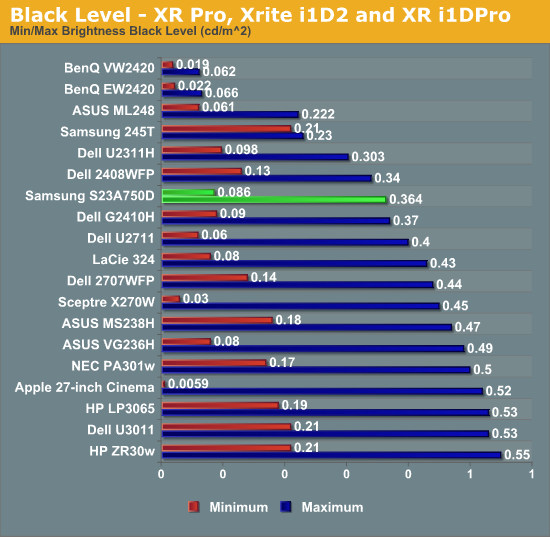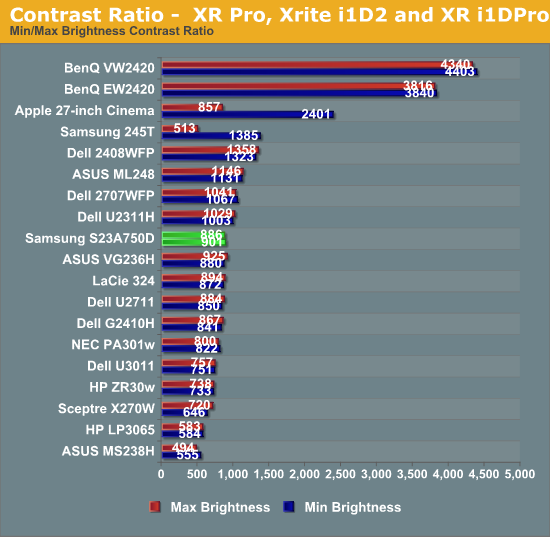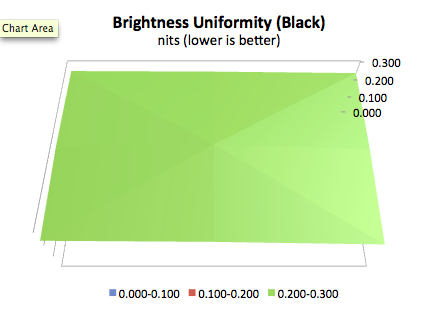Samsung S23A750D 3D LCD Display
by Chris Heinonen on December 17, 2011 2:45 PM ESTSamsung S23A750D Brightness and Contrast
The S23A can produce more light output than many monitors, with over 300 nits of light output possible. While in most cases I would say this kind of light output is a crazy amount that few people will use, the highly glossy screen on the Samsung might make this much light output useful if you have a lot of reflections around your work area from windows or overhead lights. Additionally, Active 3D glasses will cut the light output in more than half, as each eye only views the display half the time and they have tint to them, so ~25% of that light output would be 80 nits. It also manages 76 nits with the backlight brightness set to the minimum, so that gives you a very wide range to adjust the monitor to your preference.

The black output level on the Samsung falls right into the expected range for the monitor. I was a bit disappointed with this as Samsung has managed to get darker blacks out of their LED edgelit TVs, so I was hoping more of that technology would copy over to their monitors. As it is, it’s a little on the bright side for a monitor of this size.

Despite the brighter whites, the black levels rise as well and so the contrast ratios are a pedestrian 900:1 on average. That's neither spectacular nor disappointing; the contrast ratio is merely average for 2011. As usual, we test without dynamic contrast enabled, as the change in backlight intensity tends to be visible and distracting, though Samsung claims up to a 5 million to 1 contrast ratio with dynamic backlighting. (I'm not sure how they'd get there, considering the maximum white level divided by the minimum black level only results in a contrast of 3813:1; they would almost need to shut off the backlight entirely to get down to the necessary 0.000064 nits black level.)

The brightness uniformity of the S23A comes in as merely average as well. With the center at just over 200 nits, only one other area of the screen measured over 190 nits, and only one more was even over 180 nits, with the lower right of the screen measuring over 20% darker than the center.

The black uniformity was a little better, though the higher black level overall meant that none of the values were spectacular. The same lower-right area that was darker in the brightness measurements was also darkest in the black measurements, so the backlight just seems to not be as powerful in that area.











80 Comments
View All Comments
DanNeely - Monday, December 19, 2011 - link
LCDs do have potential ghosting issues from other factors; this threads so busy arguing in the weeds that it's missing the whole point.cjb110 - Sunday, December 18, 2011 - link
Minor feedback, but I think it would be better if there was a more sensible order to the pictures. I'd expect to see overview shots first and then details like the ports on the back! It's not just this article either, a few have had an 'odd' order to the pictures.Also I'd drop the power supply tale... initially thought something had gone wrong and munged two articles together! When I re-read it I thought maybe you were trying to say I *needed* a decent PSU for this monitor...which made even less sense! Still not quite sure what PSU's have to do with monitors!
UzairH - Sunday, December 18, 2011 - link
AT you have lately been reviewing TN monitors, including some pretty crappy ones, and I feel this is not helping to push the manufacturers towards introducing better quality panels (since I believe that AT reviews do have some influence on hardware manufacturers).The monitor industry has stagnated with a glut of TN panels and few IPS ones. Instead of progressing to higher resolutions and greater bit depth, what new IPS panels we are getting are actually 6-bit. It is ludicrous that the smartphones are getting higher resolutions than new notebooks and ultrabooks!
cactusdog - Sunday, December 18, 2011 - link
Stop making ignorant comments please.120Hz is a technology breakthrough. It is the future, actually the future is here but some people are stuck in the past, and comparing monitors based on old technolgy.
Most guys I know are selling their U2711's for this 120Hz monitor. If you're a gamer this monitor(or another 120hz monitor) is a must have.
This monitor compares well and has better colours than most 6 bit IPS, so saying IPS is always better is wrong. Moving image quality on a 120Hz TN monitor is MUCH better than a 60Hz IPS or VA. It also has a much clearer panel.
Sure, if you're a photographer or use cad, the higher resolution 8 Bit IPS are the way to go but as a gaming/media panel this is much better. The clear panel looks much better than Dell's crappy AG coating.
It would be nice if they introduce some 120Hz IPS or VA panels but this monitor is much better than most on the market today.
Anyway, Chris the reviewer must be new to Samsung menus, I dont have any problem with mine, but there is a knack to it that comes with experience.
Also I'm not sure if you used frame sequencial 3D when testing the 3D, most reviewers use the wrong mode when testing 3D on a AMD card.
Other reviewers have this monitor as the fastest ever tested for response time and lag, did you use the "faster" setting Chris?
If you're a gamer and still on 60Hz you're missing out.
aranyagag - Sunday, December 18, 2011 - link
I used to get annoyed whenever my dad used to say --" video games kill your brain cells" and would argue against it.Now if he said the same thing today I would say " I agree and they fry the cones (retina) too". I mean there are all these gamer panels, short (nothing taller than 16:9), low bit depth, Low resolution, TN panels. If gamers buy these there has to be something wrong with their retina as well as their neurons.
YUK
Pantsu - Sunday, December 18, 2011 - link
I don't know what's the deal with AT articles these days, but I jumped into this one straight from a RSS link, and it just jumped straight into action without any introduction whatsoever. I know there's a brief introductory piece on the front page, but I kinda miss a proper introduction chapter.This article as a whole seemed quite rushed, and didn't cover even all the basics. It's nice that there's calibration tests, but it didn't even mention that the monitor comes with Samsung's 3D glasses and Tridef software was only briefly mentioned in the conclusion. Overall the 3D section of the review was quite lacking.
I do agree the capacitive touch buttons on monitors are annoying in general and unresponsive at times, but at least this one had them illuminated, unlike my older LG 120 Hz panel, where the capacitive buttons were impossible to detect other than in perfect lighting conditions.
After a month or two of using this monitor I'd go as far as say it's probably the best 23" 120 Hz monitor out there at the moment. The only big problem is the glossy reflections, you really need to think about your room lighting before you buy a glossy monitor. Also the lack of physical adjustments might scare off some people. Other than that the Samsung panel doesn't have the viewing angle problems as bad as most TN. It works perfectly as my center monitor for my Eyefinity setup since it has thin bezels too.
ananduser - Sunday, December 18, 2011 - link
They should take a page out of Xbit Labs' monitor reviews.cheinonen - Sunday, December 18, 2011 - link
Thanks for the feedback. I'll work on making it so the review isn't so rushed at the start when coming from an RSS feed, though I don't want to have redundant information for people coming from the front page either. When the monitor was setup and in use, I really enjoyed it, but the controls on my unit were so sensitive and often unresponsive that it led me to hate to adjust it, which was a huge issue in the end. While performance is undoubtedly important, poor ergonomics and UI can make even the best product something you wouldn't want to use on a daily basis.I'm trying to get out of a backlog of displays for review so everything in the future will be as fresh as possible, but I'll make sure to be more careful than usual on the next few reviews so that any issues with readability or captions are fixed. It's also always a fine line between making assumptions about what needs to be explained in detail (such as 3D) and what can be assumed as common knowledge, as many people don't want to slog through a 5,000 word review that goes into depth about things that most people might already know. Getting feedback on what was too detailed, and what was lacking, makes future reviews better as we can properly tailor them to what people expect.
aranyagag - Sunday, December 18, 2011 - link
I agree the article seemed very abrupt. I also jumped to it via an RSS then went to the home page of AT and back again -- I though I had missed a page or 2.Starzty - Sunday, December 18, 2011 - link
Does the monitor not support 3d through HDMI using 3D Vision? You can usually force a 120hz signal through HDMI even on 3dtv displays. I have never heard of 120hz only through displayport before